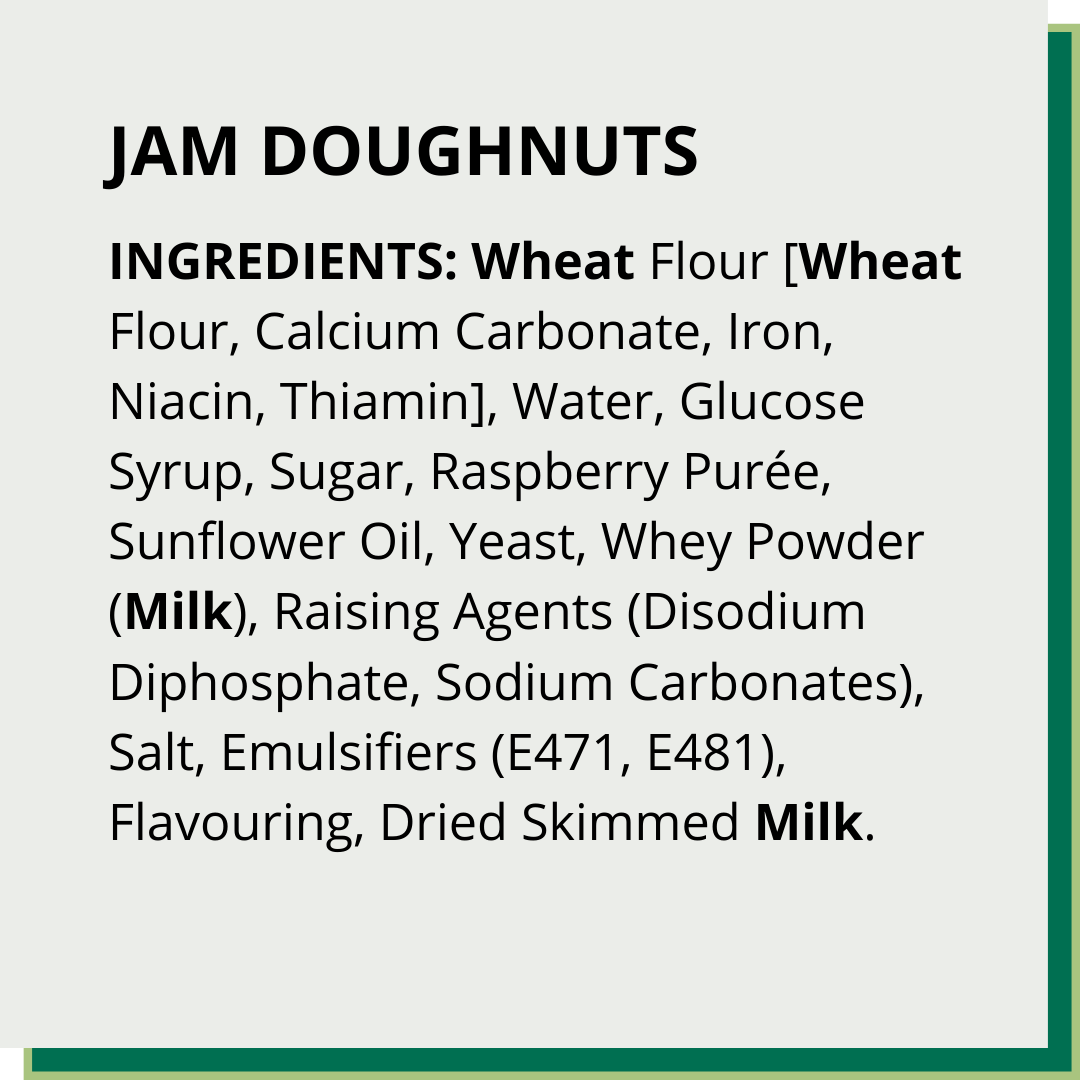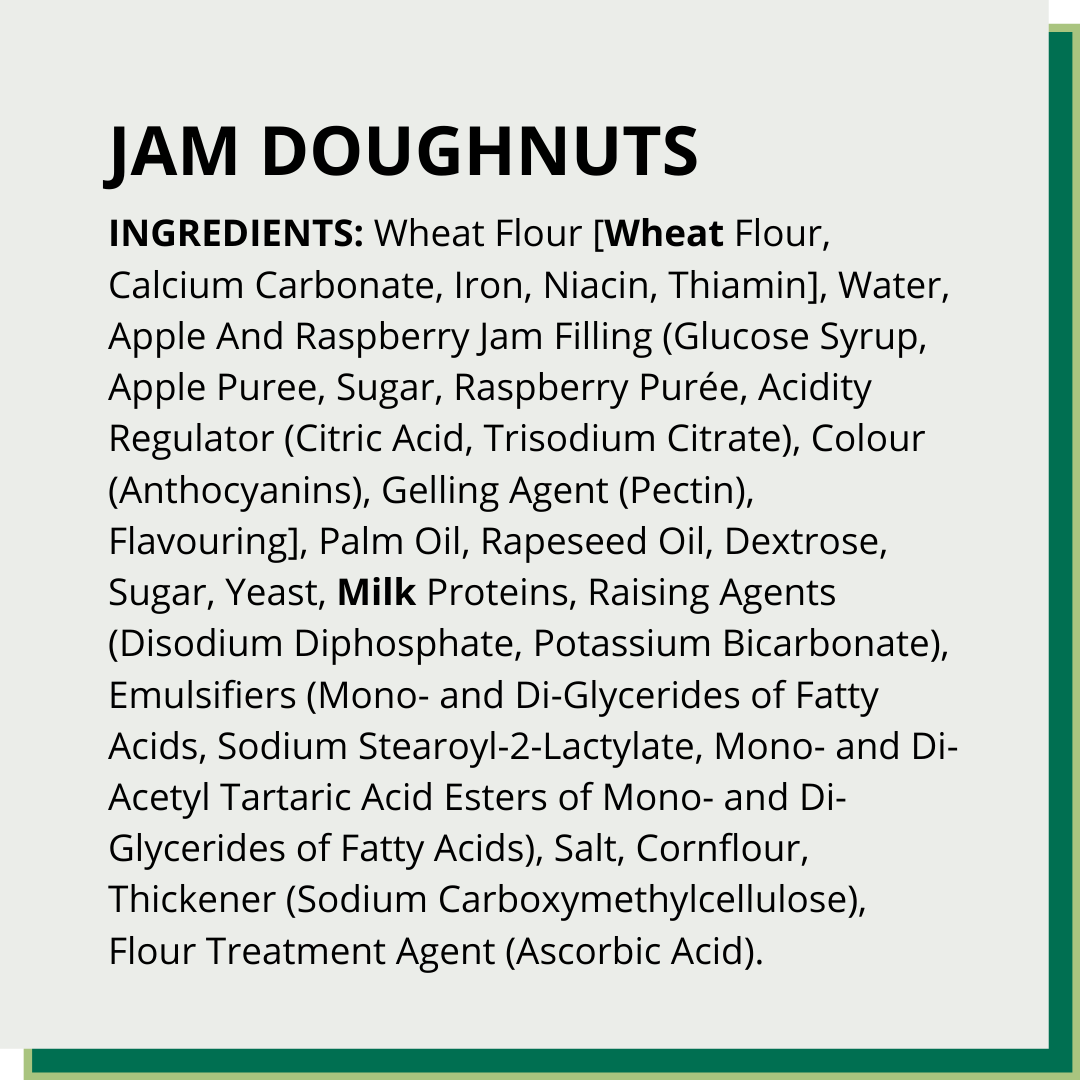Prepacked for direct sale (PPDS) allergen labelling changes for bakers
Information for bakers on the changes to allergen labelling for prepacked for direct sale (PPDS) food, also known as Natasha's Law.
From 1 October 2021 the requirements for labelling prepacked for direct sale (PPDS) food changed across the UK.
Also known as Natasha's Law, this applies to any food business that produces PPDS food, including bakeries, cake shops, tea shops, cafés, in-store counters, and home bakers who sell food from home.
PPDS food is food that is packaged at the same place it is offered or sold to consumers. It is a single item, consisting of the food and its packaging, that is ready for presentation to the consumer before it is ordered or selected.
The changes mean that food packaged before the consumer orders or selects it, and sold on the same premises (or site where a business operates from more than one location such as a shopping centre) it is packaged at, requires labelling.
For bakers and cake-makers this may mean changes to labelling for foods such as cakes, bread, sausage rolls, sandwiches, and other products.
In this guide you will find examples of PPDS food commonly provided by bakers, as well as example labels and answers to frequently asked questions from the sector.

Allergen labelling for bakers
The changes to labelling requirements in October 2021 help to protect consumers by providing potentially life-saving allergen information on packaging. This legislation is also known as Natasha’s Law.
Any food business that produces PPDS food is required to label it with the name of the food and a full ingredients list. Allergenic ingredients must be emphasised within this list.
This can include food that consumers select themselves, for example from a display unit, as well as products kept behind a counter, or some food sold at mobile or temporary outlets.
Examples of food that is prepacked for direct sale
Foods that may be provided by a baker or related food business include:
- sandwiches, cakes, bread, and pasties that are packaged on the premises prior to the consumer ordering or selecting them
- multi-packs of cakes, sausage rolls, baps, cobs or rolls packaged on the premises prior to the consumer ordering or selecting them
Examples of food that is not prepacked for direct sale
PPDS does not include food that is not in packaging when the consumer orders it, such as loaves, buns or rolls displayed loose on shelves. Food made to order and food placed into packaging at the consumer's request is not PPDS.
This can include products such as:
- unpackaged pasties, cakes, and croissants behind a glass display counter or in a hot hold cupboard
- slices of cake packed at the consumer’s request
- sandwiches and bacon rolls made to order
Non-prepacked (loose) food does not require a label and must meet current requirements for providing allergen information. This means you must provide information on the 14 major allergens to consumers. You have some choice in how you provide this information to them.
Prepacked food
You may also sell pre-packaged food that was packed at a different site to where it is offered to consumers, or food that has been packaged by another business.
This is not PPDS food, but it still requires a label with a name, ingredients list, allergens, and other mandatory details.
We have further information on labelling prepacked food and the requirements food labels must meet.
Labelling guidance for bakers
Labels on PPDS food need to show the name of the food and the ingredients list.
This includes emphasising in the ingredients list any of the 14 allergens used in the product, as required by food law. Emphasis can be added by using bold type, capital letters, contrasting colours or underlined text. This must be clear enough for the consumer to read.
Our labelling guide for PPDS food has detailed information on labelling requirements, including naming conventions, type size and precautionary allergen labelling such as ‘may contain’.
Labelling guidance for home bakers
Home bakers, who sell their food online or through other means of distance selling, will already be required to provide allergen information before food is ordered and when it is delivered.
Food sold through distance selling, without the physical presence of the consumer during the ordering process, will not be impacted by the new regulations.
However, this food will still be subject to requirements for distance selling. We have further information on food sold through distance selling and the allergen information that must be provided in our technical guidance.
If you have recently started to sell food from home, use our guide to starting a food business from home for more information on registration, food hygiene, allergen management and selling food online.
Example PPDS food label
Our labelling guide for PPDS food has detailed information on what to include on a food label, and how to present and produce it.
One example of how the label could look can be found below, but you could choose to present it differently as long as you meet the legal requirements. You must include the name of the food, a full ingredients list and emphasise any of the 14 allergens present in the food. In this example, all the ingredients in the food are in one list.

Another example of how a PPDS label could look can be found below, where ingredients are presented by mentioning compound ingredients in the food. For example, the jam filling is a compound ingredient and its ingredients are separated in the list by using brackets.

Definition of ‘packaging’
Food is PPDS if it is packaged as follows:
- the food is fully or partly enclosed by the packaging
- the food cannot be altered without opening or changing the packaging
- the food is ready for sale to the final consumer
Examples of this kind of packaging would be:
- a cake completely packaged in cling film
- bread placed in a paper bag with the bag folded over or twisted to encase the bread
- rolls contained in a plastic bag that is tied with a knot or sealed
Food is not PPDS if it does not have packaging, or if it is packaged in a way that the food can be altered without opening or changing the packaging (for example a cake served on an open cardboard tray or a baguette in an open sleeve).
Frequently asked questions from bakers about PPDS labelling
Where can I find the specific requirements for what to include on a PPDS food label?
Our labelling guide for prepacked for direct sale food has detailed information on labelling requirements, including naming conventions, type size and precautionary allergen labelling such as ‘may contain’.
How much detail do I need to provide when labelling compound ingredients?
A compound ingredient is an ingredient that is itself the product of more than one ingredient. For example, this could include bread in a sandwich, where the bread itself is made of various ingredients.
Naming compound ingredients in a list is not a requirement but can be done. For example, a sandwich label could include a list of the ingredients in the bread following the name ‘bread.’
If you chose not to list a compound ingredient under its own name, you will need to list all constituent ingredients of compound ingredients separately, in order of weight to the finished product as a whole.
Our labelling guide provides detailed information on compound ingredients and labelling PPDS food.
Do I need to change labels for food sold online or by telephone for collection and delivery?
The PPDS labelling requirements do not apply to food sold by means of distance selling. This includes food that is purchased over the telephone or on the internet.
Businesses may decide that it is easier to label all products rather than distinguish between distance and non-distance sales (such as food sold in stores). This has the advantage that the business does not have to manage different information and labelling provisions.
It also provides the consumer buying at a distance with all the information they need whilst making it easier for the business to provide mandatory allergen information without having to request it on delivery.
We have more information on allergen information requirements for distance selling.
Do I need to label leftover baked goods from other orders?
If you have leftover food, such as cupcakes, and place these in packaging before a consumer orders them, these are PPDS food and PPDS labelling rules apply.
If the cupcakes are on display without packaging, these are not PPDS food.
Do I need to label food when the consumer makes their selection based on loose display products?
If you provide the consumer food that is already packaged, and it was packed on site, then this is PPDS food.
Even if the consumer bases their choice on similar loose food that is on display, the packaged food will require PPDS labelling.
Do I need to update the label if the consumer asks for extra ingredients to be added to the food?
The food must be labelled to reflect its ingredients when packed.
If you remove PPDS food from its packaging to add extra ingredients at the request of the consumer, it does not require further ingredient labelling to reflect those changes. You should provide allergen information to the consumer in some form on the additional food you have added to the product, as well as the information on the existing label.
Do I need to label food if I buy a multi-pack item, but sell them individually?
Multi-packs, where the contents are individually packaged at another site to where they are provided, are prepacked food.
Any prepacked food sold or offered for sale must be labelled in accordance with the requirements set out in food law for prepacked food.
If individual packets from a multi-pack are separated, they should not be sold or offered if they are not individually labelled and do not comply with labelling requirements.
Do I need to label food displayed under protective domes?
If the food under a dome is a single item, consisting of food and the packaging it is placed in, and it is ready for presentation to the consumer, then this is PPDS food. If the dome is removed before the food is presented to the consumer then this is not PPDS. This is non-prepacked food.
As an example, if you have a small cake covered with a protective dome that is presented to the consumer with the dome on, this is PPDS food.
If you have a large cake under a dome, where the intention is to slice it into individual portions, and serve on a separate plate, this would not be PPDS as the large cake and the packaging it was stored in is not a ‘single item’. This is non-prepacked food.
Do the labelling changes affect food sold at farmers markets or by mobile sellers?
PPDS food is food that is packaged at the same place it is offered or sold to consumers and is in this packaging before it is ordered or selected. Food that is sold by mobile vendors or market sellers and packed by the same business at another location, before it is ordered or selected, is also PPDS food. So, if you sell food from a market stall or a van and pack the food you sell at another location this is also PPDS food.
We have more information on PPDS labelling changes for mobile sellers.
Do hot drinks, such as tea or coffee, require PPDS labelling?
Hot drinks made to order are not PPDS and do not require PPDS labelling.
But if you pour and lid drinks before consumers order them, in anticipation of a rush, the drinks would be PPDS and would need labelling.
Revision log
Published: 9 July 2021
Last updated: 17 December 2024